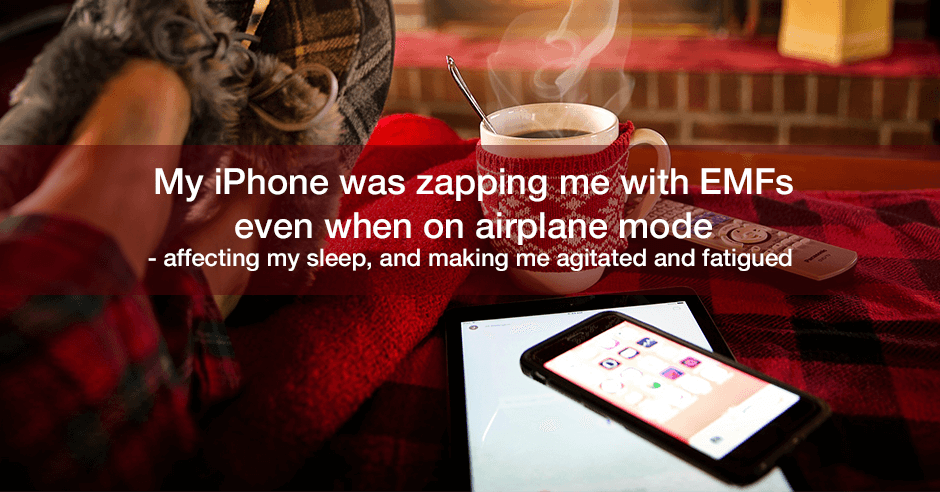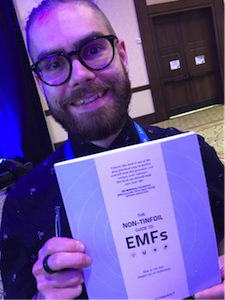
I recently got a new iPhone 6 and after having it for a good few weeks I discovered it had been zapping me with EMFs (electromagnetic fields) even when it was on airplane mode.
It was affecting my sleep, making me twitchy and agitated, leaving me feeling exhausted and more jet-lagged than usual (I had just travelled to the USA and then back to Australia) and making my right arm/mouse arm “thick” and slow when working on my PC. I have a feeling it played a role in my worsening lower back pain too!
I was NOT happy! I was actually fuming!
I have my phone on airplane mode most of time because in the last 6 months I’ve discovered I have some degree of EHS or electromagnetic hypersensitivity. This is a very real condition and many people are not even aware that EMFs may be playing a role in their symptoms.
This abstract summarizes EHS well: Characteristics of perceived electromagnetic hypersensitivity in the general population
Health problems evoked in the presence of electrical equipment is a concern, calling for better understanding for characteristics of electromagnetic hypersensitivity (EHS) in the general population.
The present study investigated demographics, lifestyle factors, frequency and duration, coping strategies, proportion meeting clinical criteria for intolerance attributed to electromagnetic fields (EMF) and comorbidity. Using data from a large-scale population-based questionnaire study, we investigated persons with self-reported (n = 91) EHS in comparison to referents (n = 3,250).
Middle age, female sex and poor perceived health was found to be associated with EHS. More than 50% in the EHS group reported having EMF-related symptoms more often than once a week, and the mean number of years experiencing EHS was 10.5. More than half of the EHS group reported that their symptoms started after a high-dose or long-term EMF exposure, that they actively tried to avoid EMF sources and that they mostly could affect the EMF environment. A minority of the EHS group had sought medical attention, been diagnosed by a physician or received treatment.
Exhaustion syndrome, anxiety disorder, back/joint/muscle disorder, depression, functional somatic syndrome and migraine were comorbid with EHS.
The results provide ground for future study of these characteristic features being risk factors for development of EHS and or consequences of EHS.
Fortunately, I used my Cornet meter and figured out something was up. Unfortunately, it took me some time to connect the dots. I figured I wasn’t feeling that great because of my recent trip and spending time sitting in planes and being exposed to so much WiFi in airports, planes, hotels, and conference rooms. I also drive a keyless car for 4 hours! Also, when you’re in the midst of this type of thing you’re kind of slow in figuring things out!
I’m going to share the lessons I learned so they can help you prevent something similar.
Lesson #1: When you toggle airplane mode off it via the swipe up feature it also activates Bluetooth and WiFi. BUT when you turn on airplane mode when using the swipe up feature, both Bluetooth and Wifi stay on unless you turn them off first in settings! This must be the default for new iPhones (and may even reset back to this with a software upgrade).



A: Airplane mode off (blue color plane) and Wifi is on and Bluetooth is on
B: Airplane mode on (orange color plane) and yet Bluetooth and WiFi is still on – this is not good if you’re using your phone next to your bed or in a car or close to your body
C: Airplane mode on (orange color plane) and Bluetooth and WiFi is off (they have a line through them) – make sure it’s like this when it’s next to your bed or in a car or close to your body
Lesson #2: Watch to see if 3G goes back to 4G when you toggle airplane mode on and off. I have changed my phone from 4G to 3G in settings in order to reduce EMF exposure when my phone is on. If you don’t know how to do this: settings/cellular/cellular data options – enable 4G toggle. Some folks are saying the airplane mode toggle reactivates 4G. I’m guessing it’s specific to the phone version as it’s not an issue on my phone.
Lesson #3: When you get a new phone or any new device, check everything and even if it’s not new, upgrades to software may change things.
Lesson #4: Distance is your friend when it comes to EMFs. I believe this impacted me more because I thought the iPhone was safely in airplane mode and not emitting EMFs. I had it close to me: in my handbag during the day when out and about, on my side-table next to my head at night, on my desk near me during the day, and in my money-belt right over my belly on the plane for 15 hours flying back!
Lesson #5: Trust your gut if you feel something is off and keep searching for a solution. I knew something was off and was prowling around trying to find what WiFi had been turned on in our home and looking for new hotspots in the area (I recently blogged about how a WiFi modem with a public hotspot caused seizures, vertigo, headaches, insomnia and heart palpitations in a woman with a history of West Nile virus)
Lesson #6: Get a meter so you can be proactive and actually measure this stuff. My Cornet meter is awesome! I’m still a newbie at this but when I see red flashing lights I know I’m onto something.
I owe much appreciation to Nick Pineault, author of The Non-Tinfoil Guide to EMFs (my Amazon link) for his amazing ElectrosmogRx practitioner training. I’ve learned so much about how EMFs are impacting our health and want to share this with you because I truly believe it’s a big player when you have ongoing anxiety, insomnia, pain, brain fog and with more serious health concerns too.
I even got to see Nick at the event I attended in the USA and got a signed copy of his excellent book!

When I shared this story on Facebook it was received with much interest and two people shared similar issues. One person said this:
Since I’ve moved I’ve been using my iPhone 6 as an alarm and getting disrupted sleep every night! Time for change!
And then shared this a few days later:
I want to report that I definitely slept better without my iPhone in the room last night!.
Someone else shared this:
Since getting the iPhone 6 I have been experiencing an overactive brain when trying to sleep plus heart palpitations. I usually sleep so well and turn off my thoughts and relax with no problems. I just thought it was a culmination of work, stress deadlines and hormones.
Too often I hear comments like this: “it’s all around us – what are we supposed to do?!” There is so much we can do!
Once I made the simple change of making sure the Bluetooth and WiFi stayed off when I toggled airplane mode on, my sleep improved, the twitchiness and agitation abated, my exhaustion ramped down and my slow mouse arm started to work normally again. My back pain is slowly but surely easing too.
As a nutritionist I always use everything at my disposal and so I’ve also used GABA for my back pain and tryptophan for the agitation and sleep issues and plenty of rosemary essential oil, together with grounding/earthing on a daily basis.
Thank goodness for my Qlink too! I’d probably have been feeling much worse had I not been wearing it 24 hours a day.
My wish now is for more folks to take this seriously!
Do you use your iPhone (or other smart phone) as an alarm without switching to airplane mode? Have you checked if Bluetooth and WiFi is off when you do switch to airplane mode?
And has disrupted sleep or other issues like anxiety, agitation, heart palpitations, pain issues, brain fog or fatigue resolved when making these very simple changes?
I’d love some feedback if you have a smart phone other than an iPhone – to share what happens on your phone and how you addressed it.